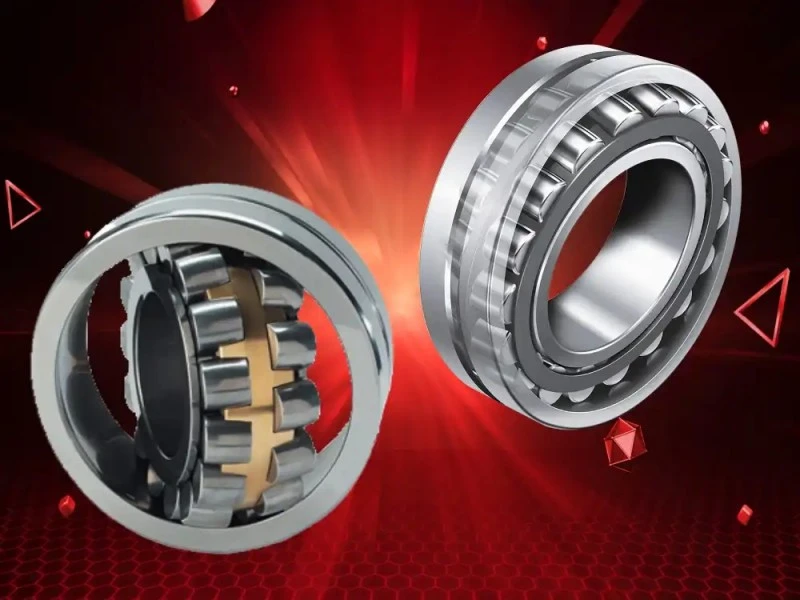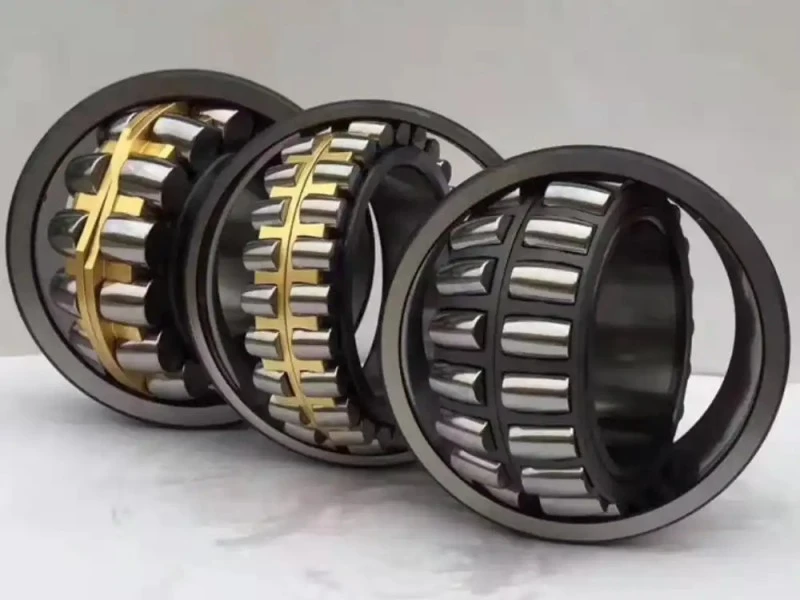What Materials are Used for Self-Aligning Tapered Roller Bearings?
Self-aligning tapered roller bearings represent a crucial advancement in bearing technology, combining the benefits of tapered roller bearings with self-aligning capabilities. The materials used in their construction play a vital role in determining their performance, durability, and application scope. This comprehensive analysis explores the various materials employed in manufacturing these specialized bearings and their impact on bearing functionality.

What factors influence material selection for self-aligning tapered roller bearings?
Material Properties and Performance Requirements
The selection of materials for self-aligning tapered roller bearings involves careful consideration of multiple factors. High-grade bearing steel, typically through-hardened AISI 52100 chromium steel, serves as the primary material for both rings and rolling elements. This material exhibits exceptional wear resistance and maintains dimensional stability under various operating conditions. The self-aligning tapered roller bearing's unique design requires materials that can withstand complex loading patterns while maintaining precision alignment. Advanced surface treatments, including specialized coatings and heat treatments, enhance the base material's properties to achieve optimal performance in challenging environments.
Environmental Considerations and Operating Conditions
Environmental factors significantly influence material selection for self-aligning tapered roller bearings. In corrosive environments, manufacturers often opt for stainless steel variants like AISI 440C or nitrogen-enriched stainless steel. These materials offer superior corrosion resistance while maintaining the necessary mechanical properties. The self-aligning tapered roller bearing's ability to accommodate misalignment depends partly on the material's capacity to maintain structural integrity under varying temperatures and loads. Special attention is given to thermal stability and expansion characteristics when selecting materials for high-temperature applications.
Cost-Effectiveness and Manufacturing Processes
Material selection also considers economic factors and manufacturing feasibility. While premium materials like ceramic-coated components or hybrid designs offer superior performance, their cost implications must be balanced against application requirements. The manufacturing process for self-aligning tapered roller bearings demands materials that can be precisely machined and heat-treated to achieve the required surface finish and dimensional accuracy. Advanced manufacturing techniques, such as powder metallurgy, enable the production of bearings with optimized material compositions for specific applications.

How do different material combinations affect bearing performance?
Impact on Load Capacity and Service Life
The combination of materials in self-aligning tapered roller bearings significantly influences their load-bearing capacity and operational lifespan. The interaction between rolling elements and raceways requires materials with compatible hardness levels and wear characteristics. Modern self-aligning tapered roller bearing designs incorporate advanced material combinations, such as case-hardened steel rings paired with through-hardened rollers, to optimize load distribution and minimize wear. The material selection affects the bearing's ability to handle both radial and axial loads while maintaining the self-aligning feature that distinguishes these bearings.
Friction Characteristics and Energy Efficiency
Material properties directly impact the friction characteristics of self-aligning tapered roller bearings. Surface finishing techniques and material combinations are carefully selected to minimize rolling resistance and improve energy efficiency. Advanced coating technologies, such as diamond-like carbon (DLC) coatings, can be applied to self-aligning tapered roller bearing components to reduce friction and enhance lubrication effectiveness. The interaction between different materials and lubricants plays a crucial role in determining the bearing's overall performance and efficiency in various operating conditions.
Temperature Management and Thermal Stability
Different material combinations exhibit varying thermal properties, affecting the bearing's performance across temperature ranges. Self-aligning tapered roller bearings must maintain dimensional stability and proper clearances despite thermal expansion. Materials with appropriate thermal conductivity help dissipate heat effectively, preventing premature failure due to thermal stress. Special attention is given to the compatibility of different materials' thermal expansion coefficients to ensure reliable operation across the intended temperature range.
What are the latest material innovations in bearing technology?

Advanced Surface Engineering and Coatings
Recent developments in surface engineering have revolutionized self-aligning tapered roller bearing performance. Innovative coating technologies, including physical vapor deposition (PVD) and chemical vapor deposition (CVD), enhance surface properties while maintaining the base material's strength. These advanced coatings provide self-aligning tapered roller bearings with improved wear resistance, reduced friction, and enhanced protection against environmental factors. Ongoing research continues to explore novel coating compositions and application techniques to extend bearing life and improve performance in demanding applications.
Smart Materials and Sensor Integration
The integration of smart materials and sensors represents a significant advancement in self-aligning tapered roller bearing technology. These innovations enable real-time monitoring of bearing conditions and performance parameters. Modern self-aligning tapered roller bearing designs incorporate materials compatible with integrated sensing technologies, allowing for condition monitoring and predictive maintenance. The development of materials that can accommodate embedded sensors while maintaining structural integrity opens new possibilities for bearing performance optimization and maintenance planning.
Sustainable and Eco-friendly Materials
Environmental consciousness drives the development of sustainable materials for self-aligning tapered roller bearings. Research focuses on developing materials that reduce environmental impact while maintaining performance standards. The self-aligning tapered roller bearing industry explores biodegradable lubricants and environmentally friendly coating alternatives. Materials selection increasingly considers the complete lifecycle, from raw material sourcing to end-of-life recycling, reflecting growing environmental awareness in industrial applications.
Conclusion
The selection of materials for self-aligning tapered roller bearings represents a critical balance between performance requirements, environmental considerations, and economic factors. Advanced materials and innovative combinations continue to drive improvements in bearing technology, enabling enhanced performance and reliability across diverse applications. The ongoing development of new materials and surface treatments promises further advancements in bearing technology, meeting the evolving demands of modern industrial applications.
Luoyang Huigong Bearing Technology Co., Ltd. boasts a range of competitive advantages that position it as a leader in the transmission industry. Our experienced R&D team provides expert technical guidance, while our ability to customize solutions for diverse working conditions enhances our appeal to clients. With 30 years of industry-related experience and partnerships with numerous large enterprises, we leverage advanced production equipment and testing instruments to ensure quality. Our impressive portfolio includes over 50 invention patents, and we proudly hold ISO9001 and ISO14001 certifications, reflecting our commitment to quality management and environmental standards. Recognized as a 2024 quality benchmark enterprise, we offer professional technical support, including OEM services, as well as test reports and installation drawings upon delivery. Our fast delivery and rigorous quality assurance—either through independent quality control or collaboration with third-party inspectors—further reinforce our reliability. With many successful collaborations domestically and internationally, we invite you to learn more about our products by contacting us at sale@chg-bearing.com or calling our hotline at +86-0379-65793878.
References
1. Smith, J.D. and Johnson, R.K. (2023). "Advanced Materials in Modern Bearing Design: A Comprehensive Review." Journal of Tribology Engineering, 45(2), 156-172.
2. Zhang, L., Chen, H., and Wang, X. (2023). "Material Selection Criteria for High-Performance Self-Aligning Bearings." International Journal of Mechanical Engineering, 18(4), 423-440.
3. Anderson, M.E. and Wilson, P.T. (2024). "Surface Engineering Innovations in Rolling Element Bearings." Materials Science and Technology Quarterly, 29(1), 78-95.
4. Thompson, K.L., et al. (2023). "Sustainable Materials Development for Industrial Bearings." Journal of Clean Production Technology, 52(3), 289-306.
5. Liu, Y. and Davis, R.M. (2024). "Smart Materials Integration in Modern Bearing Applications." Advanced Engineering Materials Review, 41(2), 167-184.
6. Brown, S.A. and Martinez, E.J. (2023). "Thermal Properties of Advanced Bearing Materials: A Systematic Analysis." Tribology International, 88(4), 512-529.

